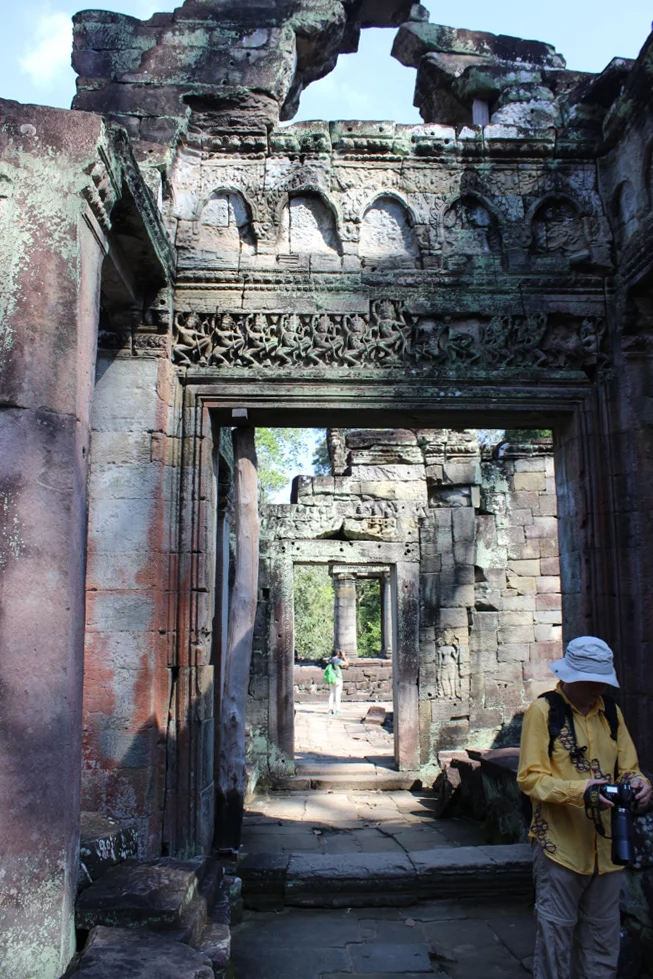The Ruins of Angkor

A thousand years ago, Angkor was a dynamic place. As capital of the Khmer Empire, it was bigger than New York and home to kings, farmers, artists and tradesmen.* It had festivals, court intrigue, and lots and lots of elephants. For six hundred years, the city was the center of Southeast Asian civilization. And then it wasn’t.
No one’s sure why Angkor was abandoned. It may have been war. It may have been plumbing. Whatever the reason, by the 15th century everyone had left. And the ruins slowly decayed into jungle.
Now only stone wats (temples) and waterways remain. The Angkor area is a World Heritage site and a tourist mecca. And since Cambodians are justifiably proud of their past, the name is everywhere - the Angkor Cafe, The Angkor Shopping Center, the Angkor Laundromat. It's even a local brand of lager!**
We didn’t drink much beer on our visit.** It was November, the end of rainy season, with the weather just starting to shift toward winter’s cool. Which in this part of the world meant 90 degrees with 80% humidity. We lost sweat by the liter and drowned ourselves in water, coke, and coconuts to make it back up.
But when we weren't sweating, we explored. The heart of the Angkor Heritage Site is of course Angkor Wat, with its iconic, asparagus towers. But that's just a small part of a much larger complex, a landscape of temples, ruined gates, and ancient walls stretching for kilometers. Most of the major sites are scattered north of Angkor Wat, accessible by two concentric loops of road. We started with the Grand Circuit, or the outer loop and bypassed the iconic landmark in favor of some of the lesser known ruins.
We hired a remorque (tuk tuk), which is a great choice if you want to stay out for the whole day.*** The shaded, breezy rides between temples cooled us down enough to stay enthusiastic. We covered about 60 kilometers, included a side trip to Banteay Srei, an exquisitely carved wat to the north.
The ancient Khmer kings were seriously into wats. (From the artwork, we can also infer their love of curvy women and vanity projects.) There are a lot of temples, both Buddhist and Hindu (the Khmer state religion was in flux). Their astonishing size and intricacy lure millions of tourists a year, yet many are still used for worship by locals.
Walking around the temples was like being in the movies, only with postcard and t-shirt booths. I sang the Indiana Jones theme as our soundtrack.
Sam might have been embarrassed, were he not so enthralled. The man loves him some ruins.
We took hundreds of pictures. Looking at them later, I realized that:
A) We are crap photographers.
B) Pictures just don’t do this place justice. Through a lens, the jungled ruins of Angkor become flat, empty buildings. And no photograph can capture the shirt-drenching heat, the wiry sound of traditional music, the sharp cries of hawkers, the smell of verdant growth and sun-heated stone. The only way to experience it is to go there.
C) Many of my favorite shots are of strangers. This surprised me. Standing in the temples, I wished everyone else would disappear. But empty buildings, while poignant, are useless. Angkor was once a city of a million residents; I guess it still looks best with people in it.
If you're not already packing, Sam will convince you to start in his upcoming post about Bayon, Ta Prohm, and Angkor Wat itself.
-Erin
*Tradeswomen, actually. Chinese diplomat and writer Zhou Daguan noted that women handled all trade in the city. For this reason, he suggested newcomers get themselves a woman ASAP.
**Angkor Beer is better than Miller Lite in that you’re in Cambodia when you drink it. But it’s not, in and of itself, worth the trip.
*** The US Department of State warns against remorques in Cambodia “due to safety concerns.” It also vetoes trains, boats, buses, cycles, and cars. Grain of salt, guys. Remorques were my favorite mode of transport. We took them around Siem Reap and Battambang with no problems.















